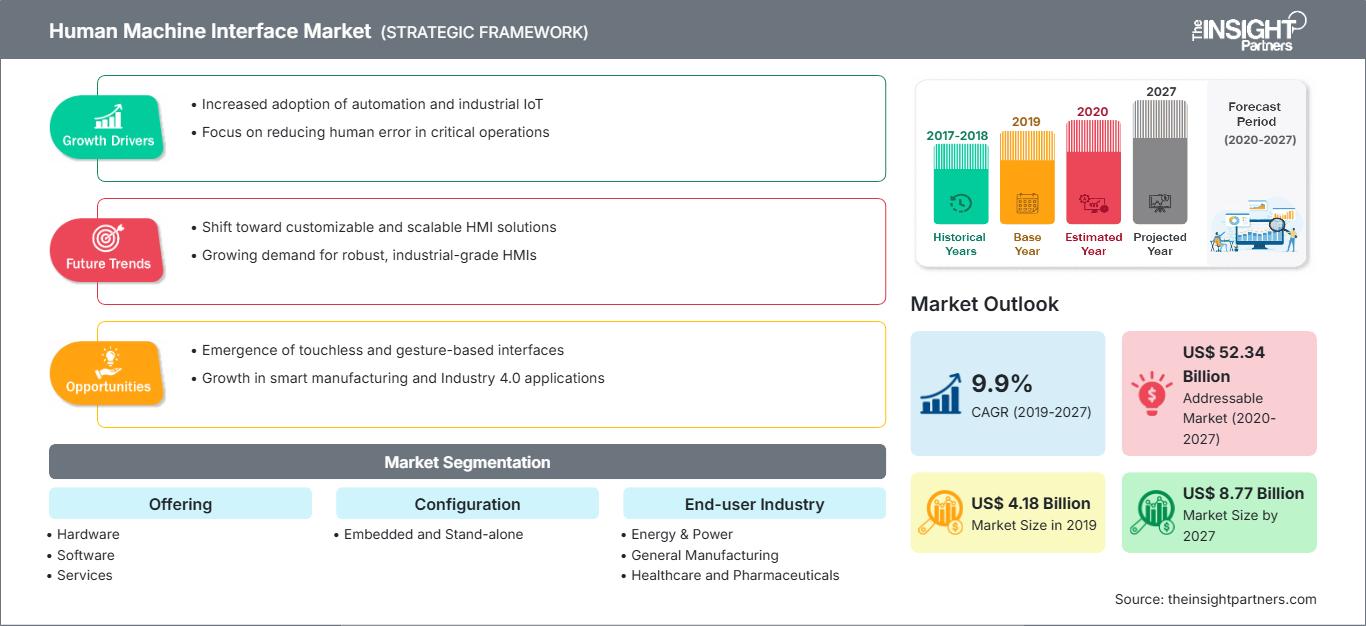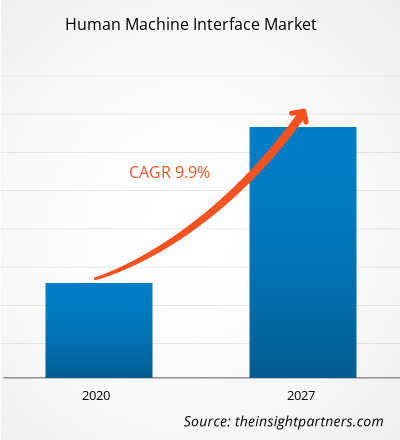Il mercato dell'interfaccia uomo-macchina è stato valutato a 4,18 miliardi di dollari nel 2019 e si prevede che raggiungerà gli 8,77 miliardi di dollari entro il 2027; si prevede una crescita a un CAGR del 9,9% dal 2020 al 2027.
Il mercato dell'interfaccia uomo-macchina è ampiamente segmentato in cinque regioni principali: Nord America, Europa, APAC, MEA e SAM. L'Europa detiene la quota maggiore del mercato globale, seguita da APAC e Nord America. Stati Uniti e Canada, collettivamente, dominano il mercato nordamericano dell'interfaccia uomo-macchina grazie ai crescenti progressi tecnologici e all'aumento delle attività di ricerca e sviluppo in settori dell'interfaccia uomo-macchina, grazie alla maggiore adozione dell'IoT e del machine-to-machine (M2M) in vari settori di questa regione. Si prevede che l'area Asia-Pacifico registrerà il CAGR più elevato del mercato, grazie alla crescita del settore manifatturiero e al crescente utilizzo di tecnologie avanzate di monitoraggio delle operazioni industriali.
L'interfaccia uomo-macchina è un'applicazione software grafica che fornisce agli operatori o agli utenti informazioni relative al processo operativo, consentendo l'interazione tra esseri umani e macchine in modo che queste ricevano istruzioni ed eseguano le attività indicate dagli operatori. In altre parole, un'interfaccia uomo-macchina (HMI) è un sistema di controllo centrale che aiuta a comunicare gli input dell'operatore e riceve dati e feedback da vari controllori logici PLC in tempo reale. Offre informazioni su ciò che accade all'interno del sistema di controllo. Questo tiene traccia di preziose informazioni di output per vari processi, inclusi conteggi dei cicli, tempi e ricette. L'HMI migliora le prestazioni dell'utente e garantisce la sicurezza dei dati. Sebbene gli elevati costi iniziali associati all'implementazione di questi prodotti rappresentino una sfida per la loro produzione, le HMI non sono limitate alle sole aziende manifatturiere.
Personalizza questo rapporto in base alle tue esigenze
Potrai personalizzare gratuitamente qualsiasi rapporto, comprese parti di questo rapporto, o analisi a livello di paese, pacchetto dati Excel, oltre a usufruire di grandi offerte e sconti per start-up e università
Mercato dell'interfaccia uomo-macchina: Approfondimenti strategici

- Ottieni le principali tendenze chiave del mercato di questo rapporto.Questo campione GRATUITO includerà l'analisi dei dati, che vanno dalle tendenze di mercato alle stime e alle previsioni.
Approfondimenti di mercato: crescente adozione di soluzioni di automazione industriale in diversi settoriLa rapida crescita dell'adozione di apparecchiature, macchinari, controller e soluzioni di interfaccia uomo-macchina automatizzati ha ottenuto un notevole successo in diversi settori verticali. Di conseguenza, si è registrata una rapida adozione di prodotti, dispositivi e sistemi dotati di interfaccia uomo-macchina per facilitare la comunicazione tra macchinari industriali e operatori. L'integrazione delle interfacce uomo-macchina offre sistemi di allarme migliorati, una gestione degli impianti superiore, funzionalità di risoluzione dei problemi, reporting e analisi e gestione delle risorse, tra gli altri vantaggi, che hanno contribuito in modo significativo all'adozione di varie applicazioni di interfaccia uomo-macchina in diversi settori finali. Inoltre, la disponibilità di sistemi integrati di supervisione, controllo e acquisizione dati (SCADA) nei settori manifatturiero, energetico, minerario, petrolifero e... Anche l'industria del gas e di altri macchinari pesanti ha favorito l'implementazione di interfacce uomo-macchina, sia nei paesi sviluppati che in via di sviluppo.Impatto del Covid-19 sul mercato dell'interfaccia uomo-macchina
Potrai personalizzare gratuitamente qualsiasi rapporto, comprese parti di questo rapporto, o analisi a livello di paese, pacchetto dati Excel, oltre a usufruire di grandi offerte e sconti per start-up e università
Mercato dell'interfaccia uomo-macchina: Approfondimenti strategici

- Ottieni le principali tendenze chiave del mercato di questo rapporto.Questo campione GRATUITO includerà l'analisi dei dati, che vanno dalle tendenze di mercato alle stime e alle previsioni.
Si prevede che il mercato dell'interfaccia uomo-macchina registrerà un calo significativo delle vendite a causa della cessazione delle attività industriali e della conseguente riduzione della domanda di servizi di integrazione e delle vendite di nuovi prodotti per l'interfaccia uomo-macchina. Inoltre, si prevede che la limitata operatività di vari produttori di componenti e fornitori di apparecchiature in diverse regioni ostacolerà la produzione di pannelli HMI e di altri componenti critici per l'interfaccia. Pertanto, è probabile che la pandemia freni la crescita del mercato almeno per i prossimi mesi.
Approfondimenti di mercato basati sull'offerta
In base all'offerta, il mercato dell'interfaccia uomo-macchina è stato segmentato in hardware, software e servizi. Alcuni prodotti basati sull'interfaccia uomo-macchina offrono funzionalità come la valutazione dei trigger, la logica integrata, la capacità di azione e la gestione degli eventi. Queste sono utilizzate principalmente per il rendering di display più elaborati, ma possono anche essere utilizzate come parte della logica del computer. Sono disponibili numerose opzioni di I/O, come ingressi e uscite digitali o analogici, a seconda della natura dell'attività, e i protocolli di comunicazione variano da semplici collegamenti RS-232 a protocolli più avanzati come SERCOS, CANOpen e comunicazioni basate su Ethernet.
Approfondimenti di mercato basati sulla configurazione
Alcuni dei progressi più interessanti nell'interfaccia uomo-macchina degli ultimi anni hanno riguardato la facilitazione dell'accesso remoto alla soluzione. Le interfacce uomo-macchina all'avanguardia dispongono anche di server web integrati che consentono di visualizzare schermate locali su qualsiasi dispositivo esterno in grado di eseguire un browser web, come desktop, smartphone o tablet. I server FTP (File Transfer Protocol) integrati consentono agli sviluppatori di eseguire l'aggiornamento e il backup remoti e semplici delle configurazioni HMI. Alcune interfacce uomo-macchina possono inviare e-mail in uscita per avvisare gli utenti sullo stato della produzione. Tali funzioni di accesso remoto possono estendere le capacità di automazione delle apparecchiature in nuovi modi e possono rappresentare un fattore significativo per la scelta di un'interfaccia uomo-macchina. Le interfacce uomo-macchina integrate hanno dominato il mercato globale delle interfacce uomo-macchina nel 2019.
Approfondimenti basati sul settore dell'utente finale
Le interfacce uomo-macchina hanno un'ampia gamma di applicazioni in diversi settori, grazie al numero considerevolmente elevato di utenti finali industriali e processi. Ad esempio, le interfacce uomo-macchina sono utilizzate in impianti di produzione, centrali elettriche, industrie petrolifere e del gas, macchinari pesanti, industrie elettriche ed elettroniche. Di conseguenza, in base al settore dell'utente finale, il mercato globale delle interfacce uomo-macchina è stato ampiamente segmentato in energia, produzione industriale generale, sanità e farmaceutica, automotive e altri. Gli altri segmenti includono i settori alimentare e delle bevande, aerospaziale e della difesa, minerario, elettrico ed elettronico e marittimo.
Gli operatori del mercato globale delle interfacce uomo-macchina adottano diverse strategie, come lo sviluppo e l'espansione dei prodotti, per ampliare la propria presenza a livello mondiale e soddisfare la crescente domanda. Adottano questa strategia per espandere il proprio business principalmente in Nord America ed Europa. I player adottano una strategia di espansione e investimento per ampliare la base clienti in tutto il mondo, il che consente loro anche di mantenere il proprio marchio a livello globale. Di seguito sono elencati alcuni dei recenti sviluppi: 2020: Rockwell ha annunciato il suo piano per l'acquisizione di Kaly, con sede in Ohio, firmando un accordo negli Stati Uniti. Kalypso è una società di consulenza e fornitura di software specializzata nella trasformazione digitale delle aziende del settore industriale con la sua suite completa di servizi di consulenza, tecnologia aziendale, innovazione digitale e gestione dei processi aziendali. Pertanto, questa acquisizione aiuterà Rockwell Automation a rafforzare il suo portafoglio di prodotti e servizi di consulenza software aziendale e architettura informativa. 2020: Rockwell Automation Inc. ha firmato un accordo per l'acquisizione di ASEM, SpA. Con sede in Italia, ASEM è impegnata nell'offerta di una gamma completa di PC industriali, hardware e software HMI, soluzioni gateway Industrial IoT (IIoT) sicure e funzionalità di accesso remoto. 2018: Rockwell Automation ha aggiornato il suo software HMI FactoryTalk View. Le nuove funzionalità di questa versione software 10.0 comprendono un maggiore accesso alle informazioni, un nuovo supporto per dispositivi mobili e una migliore integrazione tra software per migliorare la produttività.
Approfondimenti regionali sul mercato dell'interfaccia uomo-macchina
Le tendenze regionali e i fattori che influenzano il mercato dell'interfaccia uomo-macchina durante il periodo di previsione sono stati ampiamente spiegati dagli analisti di The Insight Partners. Questa sezione illustra anche i segmenti e la geografia del mercato dell'interfaccia uomo-macchina in Nord America, Europa, Asia-Pacifico, Medio Oriente e Africa, America meridionale e centrale.
Ambito del rapporto di mercato sull'interfaccia uomo-macchina
| Attributo del rapporto | Dettagli |
|---|---|
| Dimensioni del mercato in 2019 | US$ 4.18 Billion |
| Dimensioni del mercato per 2027 | US$ 8.77 Billion |
| CAGR globale (2019 - 2027) | 9.9% |
| Dati storici | 2017-2018 |
| Periodo di previsione | 2020-2027 |
| Segmenti coperti |
By Offerta
|
| Regioni e paesi coperti | Nord America
|
| Leader di mercato e profili aziendali chiave |
|
Densità degli attori del mercato dell'interfaccia uomo-macchina: comprendere il suo impatto sulle dinamiche aziendali
Il mercato dell'interfaccia uomo-macchina è in rapida crescita, trainato dalla crescente domanda degli utenti finali, dovuta a fattori quali l'evoluzione delle preferenze dei consumatori, i progressi tecnologici e una maggiore consapevolezza dei vantaggi del prodotto. Con l'aumento della domanda, le aziende stanno ampliando la propria offerta, innovando per soddisfare le esigenze dei consumatori e sfruttando le tendenze emergenti, alimentando ulteriormente la crescita del mercato.

- Ottieni il Mercato dell'interfaccia uomo-macchina Panoramica dei principali attori chiave
- Hardware
- Basato su PC
- Basato su pannello
- Altro
- Software
- On-premise
- Cloud
- Servizio
Mercato dell'interfaccia uomo-macchina - Per configurazione
- Integrato
- Autonomo
Mercato dell'interfaccia uomo-macchina - Per settore dell'utente finale
- Energia e Energia
- Produzione generale
- Sanità e prodotti farmaceutici
- Automotive
- Altro
Mercato dell'interfaccia uomo-macchina - per area geografica
- Nord America
- Stati Uniti
- Canada
- Messico
- Europa
- Francia
- Germania
- Italia
- Regno Unito
- Russia
- Resto d'Europa
- Asia Pacifico
- Cina
- India
- Corea del Sud
- Giappone
- Australia
- Resto dell'Asia Pacifico
- Medio Oriente e Africa
- Sudafrica
- Arabia Saudita
- Emirati Arabi Uniti
- Resto del Medio Oriente e Africa
- Sud America
- Brasile
- Argentina
- Resto del Sud America
Mercato dell'interfaccia uomo-macchina - Profili aziendali
- ABB Ltd.
- Advantech Co., Ltd.
- General Electric Co.
- Honeywell International, Inc.
- Kontron ST AG
- Mitsubishi Electric Corporation
- Rockwell Automation, Inc.
- Schneider Electric
- Siemens AG
- Yokogawa Electric Corporation
- Analisi storica (2 anni), anno base, previsione (7 anni) con CAGR
- Analisi PEST e SWOT
- Valore/volume delle dimensioni del mercato - Globale, Regionale, Nazionale
- Industria e panorama competitivo
- Set di dati Excel
Report recenti
Rapporti correlati
Testimonianze
Motivo dell'acquisto
- Processo decisionale informato
- Comprensione delle dinamiche di mercato
- Analisi competitiva
- Analisi dei clienti
- Previsioni di mercato
- Mitigazione del rischio
- Pianificazione strategica
- Giustificazione degli investimenti
- Identificazione dei mercati emergenti
- Miglioramento delle strategie di marketing
- Aumento dell'efficienza operativa
- Allineamento alle tendenze normative




















 Ottieni un campione gratuito per - Mercato dell'interfaccia uomo-macchina
Ottieni un campione gratuito per - Mercato dell'interfaccia uomo-macchina